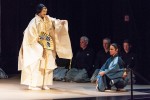Elvis Presley comes back to life in traditional Japanese theater in “Blue Moon Over Memphis.”
Theatre Nohgaku, a Noh theater company, will perform the play as part of “2 Days of Noh,” a symposium on the classical Japanese musical theater form. The production will be held alongside an exhibit of Noh masks and a lecture from Noh theater scholar Mikio Takemoto. Thomas O’Connor, a UCLA associate professor of acting and a member of the theater company, helped organize the events and said that though “Blue Moon Over Memphis” follows a traditional Noh story, it is an American adaptation of the classical style.
“We’re not trying to steal or take anything from the culture or stories of Japan,” O’Connor said. “What we’re trying to do is immerse ourselves into the training so we can have a deep and rich means of telling our own stories.”
Noh theater has existed for over 600 years, and its long history distinguishes it from other theater styles, O’Connor said. It is constantly being taught to new practitioners, with productions being passed down from generation to generation. Noh is upheld through the physical, written copies of each score combined with the daily physical practice, O’Connor said. Traditional Noh training is conducted in large groups under a master’s tutelage. Progress is not considered in terms of perfection or mastery, O’Connor said, but is instead measured in comparison to the growth of those around them.
When going about performing “Blue Moon Over Memphis,” O’Connor said the company wanted to recreate a “shinsaku Noh,” or “newly made Noh,” but in English to be more accessible to an American audience. Playwright Deborah Brevoort mirrored the play’s structure after phantom Noh, in which a person from the past returns first in an alternate form before appearing in their more well-known form. “Blue Moon Over Memphis” follows Presley fan Judy, who meets the singer’s ghost while on a trip to his mansion Graceland. Presley first appears as a bluesman, and then again as his recognizable self.
Noh requires a high level of spatial knowledge and awareness, O’Connor said, while also requiring a strong relationship between the core of one’s body and the periphery. Because each gesture in Noh reflects something bigger than itself, any extraneous movement may diminish the gesture’s meaning, he said. Pointing, for example, draws attention to something else on stage, and extra movement could detract from such attention.
“The actor must be absorbed, every cell of his body, in the gesture. Not in a casual way, but in a very deep and serious way,” O’Connor said. “It’s very hard to sustain that level of attention to craft.”
Each physical choice of the actor is meant to emphasize some aspect of the production, said co-director and actor John Oglevee. Even simple actions, such as standing, still draw attention to the artistry of the costumes and masks, he said. “Blue Moon Over Memphis” features two masks created by master carver Kitazawa Hideta – one of blues singer-songwriter Robert Johnson that is used in the first act and one of Presley for the second act, said actress Elizabeth Dowd. Though the masks include stylized art and bright colors, the features, such as the dark hair, are still recognizably Presley.
Oglevee said since Noh movements are based around the costume’s structure, the costumes had to be reminiscent of the traditional style while also reflecting the American nature of the production. One costume is a kimono made out of thrifted denim jeans, allowing the character to reveal a casualness inspired by American clothing styles, while still being bound by the traditional Noh kimono forms. The patched pattern also reflects classical Noh style; when a character’s outfit features a lot of squares, it reflects the multitude of issues in their life.
The play also features a number of Presley songs in Noh style, such as the lyrics to Presley’s version of “Unchained Melody” chanted on stage. In combining so many American aspects, Dowd said they aimed to create a level of familiarity for the audience.
